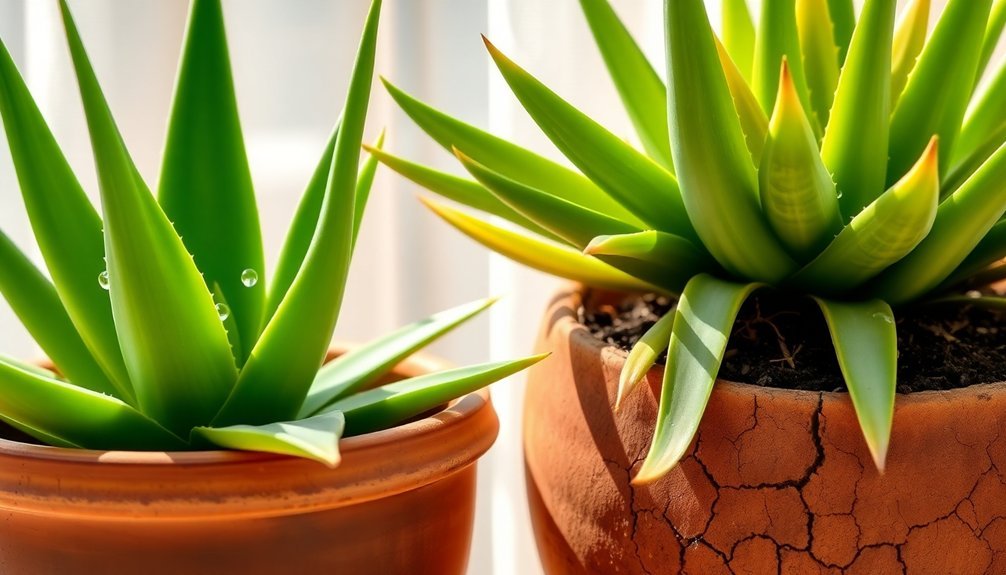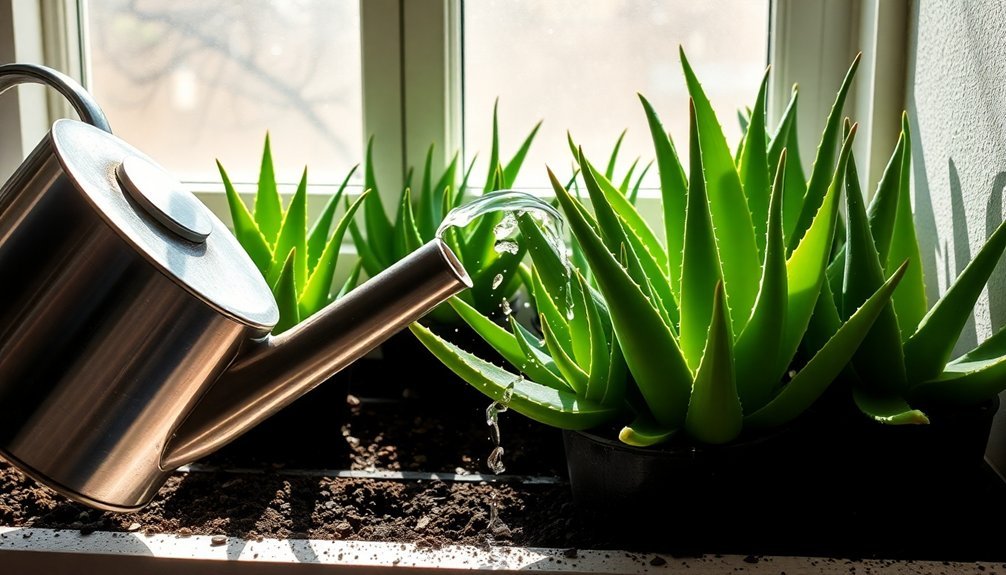Water your potted aloe plant every 7-14 days during spring and summer, then reduce to every 2-3 weeks in fall and 4-6 weeks in winter. Always check that the top 3-4 inches of soil feels completely dry before watering. When you do water, saturate until it drains from the bottom of the pot. Watch for firm, bright green leaves as signs of proper hydration. A deeper understanding of your aloe's natural water cycle will help you perfect this schedule.
Understanding Your Aloe's Natural Water Cycle

While aloe plants are incredibly resilient, understanding their natural water cycle is essential for proper care. Your aloe's native habitat provides valuable clues about how to water it properly. These desert-dwelling plants thrive in conditions where they receive concentrated periods of water followed by long dry spells.
You'll want to mirror this natural cycle by allowing your aloe's soil to dry thoroughly between waterings. During spring and summer, water your plant every 7-14 days, but reduce this to once every two months in winter when it's dormant.
Before adding any water, check if the top 3-4 inches of soil feel dry. Remember, too much water can lead to root rot, so it's always better to underwater than overwater your aloe. Good drainage is key to preventing moisture-related problems.
Seasonal Adjustments for Optimal Watering
Because aloe plants follow natural growth cycles throughout the year, you'll need to adjust your watering schedule accordingly.
During spring and summer's active growth period, water your Aloe plant weekly, but first verify the top inch of soil is dry. As fall approaches, extend the time between waterings to 10-14 days while your plant shifts toward dormancy.
Winter requires the most significant adjustment, as your aloe's watering needs decrease dramatically. You'll only need to water every 2-3 weeks during these cooler months when the plant is in its hibernation state.
Always check soil moisture by inserting your finger 3-4 inches deep before watering. Remember that environmental conditions matter too – warmer temperatures and bright light may require more frequent watering, while cooler conditions need less.
Signs of Healthy vs. Unhealthy Watering Patterns

How can you tell if your aloe plant is receiving the right amount of water? A healthy aloe vera displays firm, bright green leaves, signaling proper hydration.
When you're getting it right, the soil will feel dry about 1-2 inches deep before you water again.
Watch for warning signs that indicate poor watering habits. If you're overwatering, you'll notice root rot developing beneath the soil, causing your plant's leaves to become soft and droopy. The roots may turn black and mushy.
On the flip side, underwatering leads to shriveled, dry leaves. Leaf discoloration, particularly yellowing, often points to inconsistent watering patterns.
You'll need to adjust your watering schedule with the seasons, providing more frequent water during warm months and reducing it during winter to maintain ideal plant health.
Creating a Year-Round Watering Calendar
Understanding the seasonal shifts in aloe care lets you map out a reliable watering schedule for the entire year. Your Aloe Vera plant requires different watering frequencies as the seasons change.
In spring and summer, water your plant every 1-2 weeks, waiting until the top soil layer becomes completely dry.
As fall approaches, stretch out the intervals to every 2-3 weeks to accommodate your plant's slower growth phase. During winter, you'll only need to water every 4-6 weeks since your aloe enters its most dormant period.
Before each watering session, check the soil moisture by inserting your finger 2-3 inches deep.
Adjust this basic schedule according to your home's conditions – brighter, warmer spaces may require more frequent watering, while cooler areas need less.
Fine-Tuning Your Watering Technique

A successful watering routine for your aloe plant depends on mastering the right technique. Before you water thoroughly, check soil moisture in the top 1-2 inches – it should feel dry to the touch. When watering, pour until you see drainage from the bottom of the pot, guaranteeing deep root hydration.
| Aspect | What to Do | Why It Matters |
|---|---|---|
| Soil Check | Insert finger 1-2" deep | Prevents overwatering |
| Amount | Water until draining | Guarantees deep hydration |
| Soil Type | Use well-draining soil mix | Prevents root rot |
| Frequency | Weekly in growing season | Matches growth needs |
| Container | Consider pot size/material | Affects water retention |
You'll need to adjust your technique based on your pot's characteristics – unglazed terracotta requires more frequent watering than plastic containers. Remember that proper drainage is just as important as the amount of water you provide.
Frequently Asked Questions
How Often Should I Water My Potted Aloe Vera Plant?
You'll need to water your aloe vera every 1-3 weeks. Check if the top 1-2 inches of soil are dry before watering. In winter, reduce watering to every 2 months to prevent overwatering.
How to Tell if Aloe Vera Needs Watering?
Insert your finger into the top 3-4 inches of soil; if it's dry, your aloe needs water. Watch for signs like wrinkled leaves indicating thirst, or yellow leaves suggesting overwatering. Always check before watering.
Should I Cut the Brown Tips off My Aloe Plant?
Yes, you can safely trim brown tips from your aloe with clean, sharp scissors cut at an angle. But first, identify what's causing the browning so you can adjust care and prevent future damage.
Do Aloe Plants Need Direct Sunlight?
No, your aloe doesn't need direct sunlight. It'll thrive best in bright, indirect light for at least 6 hours daily. While it can handle some morning sun, avoid harsh afternoon rays to prevent leaf burn.
In Summary
Your aloe's long-term health depends on finding the right balance in your watering routine. Remember you'll need to adjust your schedule based on seasonal changes, pot size, and indoor conditions. Don't hesitate to modify your watering calendar if you notice signs of over or under-watering. With consistent monitoring and these guidelines, you're well-equipped to maintain a thriving aloe plant year-round.





Leave a Reply